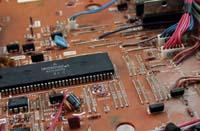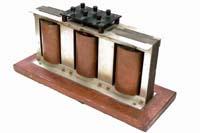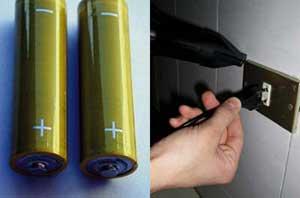Electricity between hands

Electrons move by themselves. That is not what we call electric current. However, if we place the electrons between two electric poles, a real current of electrons is generated (electrons are negative electric charges). And that's what we call electric current. In short, the electric current represents the movement or transport of electric charges, which occurs under the influence of the electric field.
Since the transport of electric loads can occur in different types of materials, it will be very important to take into account the characteristics of each material, electrical conductivity, etc.
That is, in some materials it is very easy to do, in others it is not. Metals, for example, transport electric loads more appropriately than any other, but not wood.
In general, electric charges move from a point of greater potential to the point of lower potential, from the positive to the negative pole. Always in that sense. As with gravity, bodies fall from top to bottom and not the other way around. This constant movement is called continuous current and is in nature.
In direct current, the movement of electric charges can be compared to the liquid movement of the pump-driven molecules in a closed hydraulic circuit. The function of the pump is to move the liquid and, in the case of electricity, the voltage provided by the electromotive force is the one that moves the electrical charges of the electric circuit.

However, the fact that the positive pole is in Vitoria and the negative in Donostia, for example, makes no sense. Formerly it was consumed where electricity was produced and the direct current was mainly used. However, when the need to transport electricity over long distances arose, the alternating current prevailed to avoid, among other things, the energy losses that occurred during transport.
To obtain alternating current, the electric poles are exchanged cyclically. The exchange of electric poles represents a change in the meaning of the current, and the cyclic exchange gives rise to an electric current that continuously changes meaning. That is, as the name suggests, the alternating current. And that has been invented by man, it is not in nature.
Direct AC current
Both direct and alternating, an electric generator is needed to generate current. The electric generator will create a suitable electric field to maintain the electric current sustainably.
The direct electric current used by humans can have various sources or generators. In batteries, for example, electromotive force and potential difference are obtained through chemical processes. In the dynamos, mechanical energy is transformed into electrical energy. In addition to these two conventional pathways, there is another way of obtaining direct current consisting of rectifying the alternating current. The rectifiers allow to obtain a one-way current, eliminating the opposite direction. Then, by means of electric filters the voltage variation can be softened and the current reached at the end of the process is practically smooth and constant.

Today it is necessary. In fact, alternating current is the current that comes to the homes and the television with which we feed the musical apparatus, the washing machine and the fridge, but then all the internal electronics of these works with direct current. Therefore, among other things, they have a rectifier to convert alternating current into direct current. And other elements like transformers.
Home
Undoubtedly, the invention of the transformer was enormous. Among other things, it faces the energy losses that occurred in transport.
XIX. Developed at the end of the 20th century, it is a fundamental component of power supply networks. It can convert a low intensity and high voltage current into a high intensity and low voltage current (and vice versa), without just losing energy.

This conversion is important. This is because the higher the voltages, the better the performance of the electric power transmission, but the lower voltages are more suitable for generation and use. If there were no transformers, it would be necessary to shorten the distances between generators and users; many homes and industries would need their own power plant and electricity would not be a comfortable type of energy.
In addition to its function in the power supply network, the transformer is an integral component for many objects using electricity. Table lamps, battery chargers and television sets, for example, have transformers that allow to increase or decrease the voltage.
If not, imagine yourself home, for example, with a current of 150 million volts. It would be impossible. The current that reaches homes in Europe is 220 volts and has a frequency of 50 Hz. In the United States, for its part, it reaches between 110 and 120 volts at a frequency of 60 Hz. Therefore, it is advisable to read the instructions of electrical appliances before plugging them into the network.
If you go on vacation abroad and buy an electric appliance, or vice versa, it is very possible that you take your mobile, digital camera or laptop. Often, in these cases, we do not consider that the AC voltage is not the same in all countries, nor is frequency. To address this problem, many of the devices currently have universal adapters.
Health condition

We cannot forget, for example, the unpleasant and dangerous consequences of the electric discharge of the voltage of 220 volts in the plug. In general, AC is more dangerous than DC. In fact, the effects of the alternating current on human bodies depend largely on their frequency. The lower the frequency, the more dangerous it is, and between 3 and 4 times more dangerous is the alternating current than the direct current to the same voltage and intensity.
Direct current causes muscle contractions and, in most cases, the affected person moves immediately from the energy source. On the other hand, the impact of the 60Hz alternating current is more violent, leaves the muscles hardened and therefore it is more difficult to free them from the power source. If it persists, serious burns can occur. In general, the higher the voltage and current intensity, the greater the damage, regardless of the type of current.
The use of risks, both direct and alternating current, is extensive. In addition, the latter easily transforms unlike the DC, facilitating its accumulation and reducing energy loss in transport from one to the other. Today no one would imagine a world without electric currents, that is, without electricity.

Knowing all this, it is easy to understand why many people have cramps when touching something. The problem is that due to wind and heaters the skin is very dry. The skin, therefore, is charged with a positive sign, especially if wearing polyester clothing, since polyester takes a negative sign. This load is accumulated in the body until it finds static, any metallic object or any other person. Touching it moves the accumulated load and an electric shock occurs. Conclusion: a cramp is felt.

Buletina
Bidali zure helbide elektronikoa eta jaso asteroko buletina zure sarrera-ontzian











